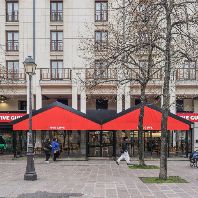Despite the fact that so-called 'core' retail real estate is highly coveted by investors, the way in which these investments are currently being defined does not ensure long-term security or a sufficient number of qualifying objects for acquisition-oriented investors. Manuel Jahn, GfK retail real estate expert at GfK GeoMarketing, offers a more serviceable definition of 'core' in a new white paper.
GfK GeoMarketing is publishing a white paper that offers a new definition of 'core' retail real estate and discusses its advantages. The author Manuel Jahn - Head of the real estate consulting division at GfK GeoMarketing - draws attention to the misunderstandings and risks associated with the current definition of 'core': "Given the fact that there is no authoritative definition in this regard and yet the 'core' concept remains dogma among investors and asset managers, it is essential to come up with guidelines for a better, more unified use of this term in the realm of retail real estate."
What is 'core' retail real estate?
The general consensus is that core objects in the retail sector are good locations that offer stable, long-term rental cash flow. The value of the real estate object and the image of the investment location are frequent points of focus.
"These latter criteria are, however, usually inadequate with regard to identifying the key opportunities and risks," writes Jahn.
Jahn goes on to indicate that it still makes sense to pursue well-known, credit-worthy tenants with long-term rental contracts, assuming that these tenants reach their turnover goals. GfK GeoMarketing has observed that between 60 and 80 percent of rental contracts for German shopping centers are adjusted in some way before the termination of the contract period.
New definition of 'core'
The drawing power of a given retail real estate object with regard to end customers is the primary driver of success, according to Jahn: "The ability to draw customers is the key to the long-term economic success of retail real estate. Regardless of the type of retail real estate, location drawing power is an expression of the competency of the offering, conception and management."
The white paper proposes a definition of 'core' retail real estate that is more attuned to this requirement: "A core strategy in the retail real estate segment is the investment in existing real estate that is oriented to the shopping needs of end customers and that supplies rental cash flow commensurate with the sustainable turnover potential generated by the tenants.
Turnover potential and the amount of rent commanded by this type of retail real estate are expressions of the long-term absorption of the available purchasing power volume. Supported by active asset management, core real estate objects facilitate the implementation of long-term investment strategies that offer sustainable, value-stable leasing to retail tenants."
Benefits of the new definition
According to Jahn, the new definition of 'core' retail real estate gives investment managers, committees and boards a significantly larger selection of prospective investments: "Investors can get a better foothold in the currently security-oriented atmosphere of the retail sector by taking advantage of the untapped potential beyond the large cities focused on by the mainstream core investment strategy."
Profitable endeavors can also be realized in second- and third-tier cities, which may offer even better opportunity-risk profiles than some high-street or metropolitan real estate.
"A thorough location and market analysis can offer assurances for the security of these previously unviable investments in secondary locations that more than meet the requirements of the core investment strategy," writes Jahn.
The four success factors of retail investments
Below are the prerequisites for the success of retail real estate and, as such, key features of the new definition of 'core' retail real estate:
1. Responsive to the shopping needs of end customers
As cons















